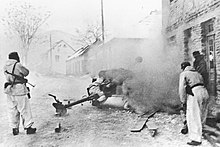Operation Kugelblitz
| Operation Kugelblitz | |||||||
|---|---|---|---|---|---|---|---|
| Part of World War II in Yugoslavia | |||||||
 |
|||||||
|
|||||||
| Belligerents | |||||||
|
Axis: |
Allies: |
||||||
Operation Kugelblitz ("ball lightning") was a major anti-Partisan offensive conducted by German forces in December 1943 during World War II in Yugoslavia. The Germans attacked Josip Broz Tito's Partisan forces in the eastern parts of the Independent State of Croatia in an attempt to encircle and destroy them, thereby preventing the Partisans from entering the Territory of the Military Commander in Serbia. Operation Kugelblitz was followed up immediately by Operation Schneesturm (Blizzard) which sought to capitalise on the initial success of Operation Kugelblitz. Both operations are associated with the Sixth Enemy Offensive (Serbo-Croatian: Šesta neprijateljska ofenziva/ofanziva) in Yugoslav Partisan historiography.
Operation Kugelblitz, the first of the offensives, was executed by the 5th SS Mountain Corps. The purpose of this operation was to destroy the Partisan units in eastern Bosnia. But the plan was overly ambitious. The German troops committed to this action were tasked with covering too large an area. The bulk of the Partisan force slipped through the large gaps in the narrowing ring. However, the cost of Kugelblitz to the Partisans was claimed at approximately 9,000 casualties.
Operation Schneesturm followed immediately upon the completion of Operation Kugelblitz. This operation included twin drives from the Bosnia area. One drive went to the west and to the coast. The other drive went to the northwest and towards the border with Italy. While this operation ended late in December and the Partisans once again survived, the cost was high. The Partisans suffered about 2,000 additional casualties.
Though badly battered, the majority of the Partisan units retained their cohesion. Tito's army could still be considered an effective fighting force.
...
Wikipedia
